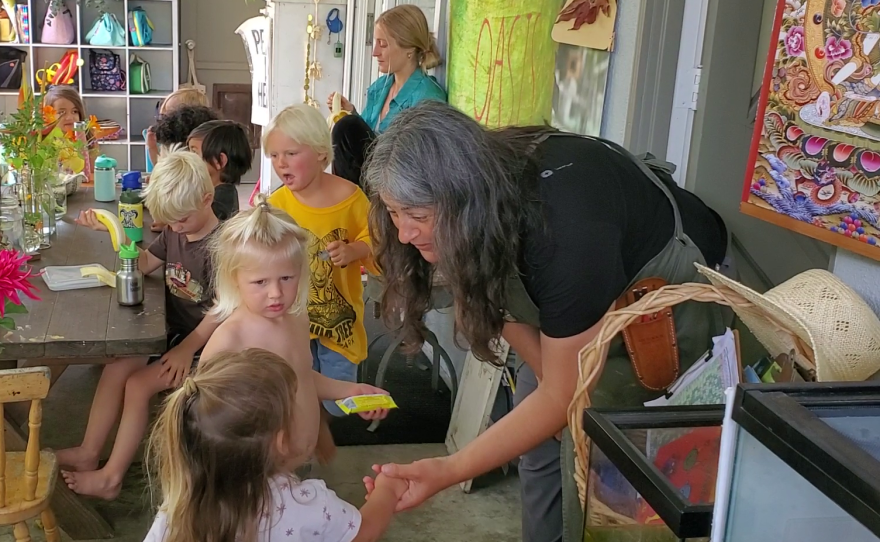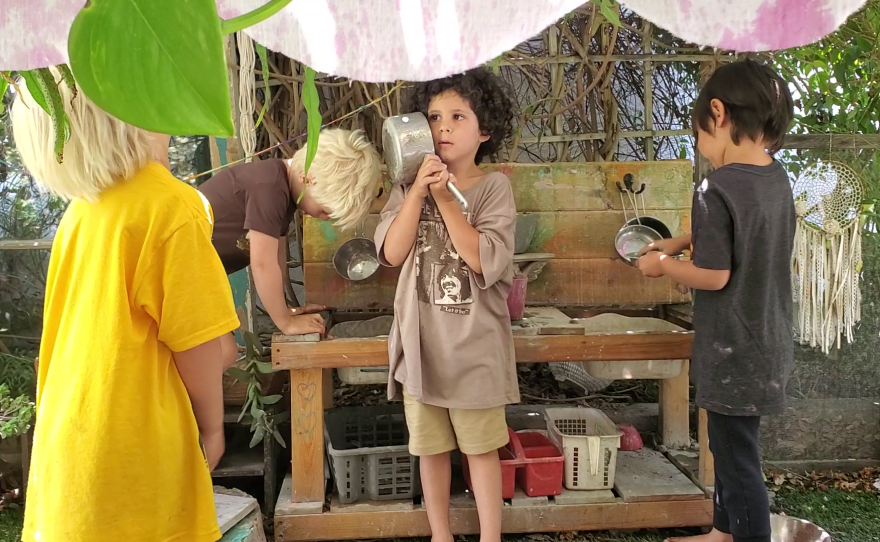This is part two of a two-part series. Read part one here.
A dozen young children sit in a circle on the sun-speckled lawn of Liberty Winn’s home child care in Carlsbad.
After singing their school song— “We are Oasis, mighty mighty Oasis” — she dismisses them one by one to leave the circle, visit the potty, and then pick out their snacks.
“If your name starts with Z, you may go, how about Zaden?” Winn calls. “Z-A-D-E-N?”
The idyllic scene belies the more than two years of turmoil Winn has faced in the age of COVID-19. When the pandemic hit, she closed for two months — from mid-March until mid-May 2020.
“And then within two weeks, we got the eviction notice,” Winn said.
Her landlord said his family was moving back into the home Winn was renting. She frantically searched for a new place — where she could both live and have her child care business — and ultimately found the building in Carlsbad.
But moving out of her home for the past 18 years making her new place suitable for children required that Winn take out a federal Emergency Disaster Relief Loan. Winn said she then spent almost $20,000 on the rental property, even though she only had a one-year lease.
“It was an extraordinary amount of money to put into a place,” she said. “But I didn't really see a choice and it seemed like the next step to keep my business going.”
Winn's lease will be up this summer and she just received more bad news — her landlord won’t renew. He plans to turn the property instead into a luxury Airbnb. So, Winn is out of business again, and now she’s closing permanently and moving back to be with family in the Bay Area. She hopes to start from scratch and open a new child care there, and just requested an increase to her loan to do it.
Winn’s story illustrates just one more challenge that child care providers face in San Diego County. Being in the business these days means staffing shortages, caring for children who are still not able to be vaccinated for COVID-19 and a business model that even in the best of times operates on a razor-thin profit margin.

Now they’re also dealing with a skyrocketing housing market.
The result is essentially a crisis on top of a crisis. State data show that 1 in 8 child care businesses temporarily closed during the past two years. And many have struggled to re-open due to staggering rental costs.
According to a recent survey from the San Diego YMCA, 37% of home child care providers rent their facilities and 93% of them would prefer to own.
“We need more child care in San Diego County, and there are two ways of that happening,” said Laura Kohn, a long-term early education expert who has started a child care real estate fund at the investment firm Mission Driven Finance.
“One is for the existing providers to expand to serve more kids, and the other is to bring more providers into the field. And real estate and the rental market are a huge barrier in both of those areas.”
'A terribly vulnerable position'
It is a nationwide problem but particularly acute in San Diego, where rents have shot up 21% to 23% in just the past year. So more and more child care businesses risk being forced into a transient existence.
“The child care provider is totally dependent on that rental situation for their livelihood and moving the business would be incredibly disruptive to a lot of parents and families, as well as to the provider's business,” Kohn said. “So, it puts the providers in a terribly vulnerable position.”
Kohn went on to say that stories like Winn’s are becoming commonplace.
“I've talked to many providers who thought they were in a stable lease, who thought they were going to be in a space for a long time, so they invested tens of thousands of dollars to make the space what they felt it needed to be to best serve children,” Kohn said. “And then they got evicted. And that money is just completely down the tubes for them.”
A California law protects child care providers from discrimination by landlords for running a child care business, but in a competitive rental market, landlords will still frequently choose tenants who aren’t planning to care for children in their homes, Kohn said.
Tatiana Zaytseva moved to San Diego from Russia three years ago and planned to open her own home child care center. She got the license approved a month before the COVID-19 pandemic descended, but still managed to begin caring for four children in her small apartment in Carmel Valley. That wasn’t enough for her to turn a profit, so she looked to expand.
But a larger license to care for 14 children would require more space, so she tried to rent a larger home. There was nothing in her price range.
“I cannot afford a new house or new townhouse for child care and I was not just upset, I was disappointed and unmotivated,” she said. “I needed to find for example $5,000 or $6,000 per month to pay for rent.”
'Truly broken'
Without government funding to help providers like Zaytseva and Winn, child care availability will continue to decline, said Kim McDougal, the executive director of the San Diego County YMCA’s Childcare Resource Services.

“The funding mechanism for child care is truly broken, and the way we have built our economic model is truly broken,” McDougal said. “And that's something that we really need to address going forward if we're going to solve the child care crisis, because parents can't pay more, providers can't charge less, and it's never going to match up without public subsidy to close the gap.”
Kohn is working on a plan that she hopes will help: a child care real estate fund that would buy properties in the region and rent them to providers as a child care-friendly landlord. As the properties grow in value, the fund would share those profits with providers to help them eventually buy the space.
They already have a $1 million grant for the fund, along with other financial backers, and plan to launch it later this year. By the beginning of 2023 they plan to have purchased their first five properties.
That will come too late for Winn. She will have to pack up or sell everything—from the art supplies and tiny tables and chairs to the aquariums holding snakes and turtles. And all of the money she put into the property will be lost.
“I've been riding this edge, hoping that I'm doing it gracefully, but knowing that there's a deficit coming out of it, I’m had to realize how very vulnerable I am,” she said. “I'm so grateful to have found my calling and have a business that was flourishing and serving the community, and I seem to be in my element. But if I really think about it, I'm extremely vulnerable, and that's a terrifying feeling.”









